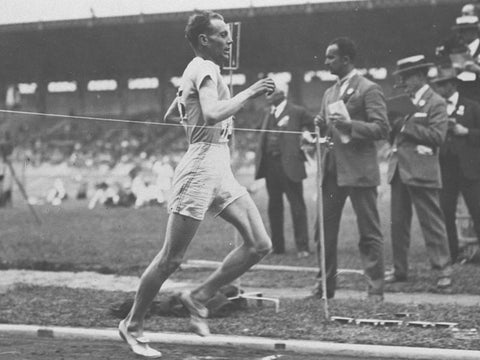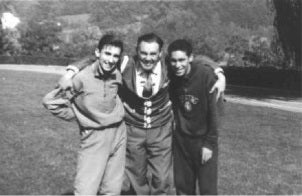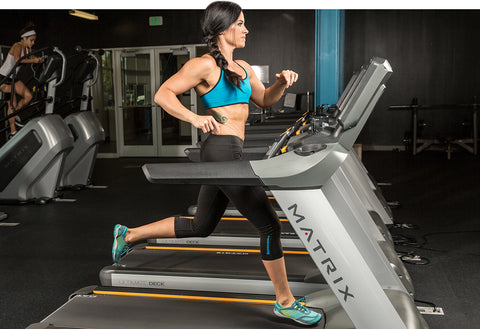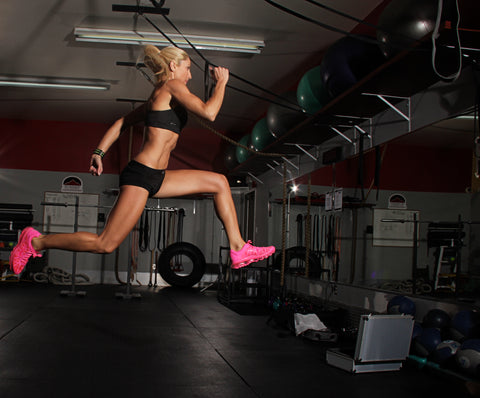High Intensity Interval Training (HIIT) is a type of physical training that involves fast, intense bursts of exercise, followed by brief, intervals with much lesser intensity.
This can be conducted on almost all cardio machines, including bikes, treadmills, rowers and even cross trainers.
HIIT offers significant benefits including to be much more efficient than regular (sold state) cardio. This is because the workout intensity is higher and you can raise both your aerobic and anaerobic stamina while burning fat. The extreme "sprint" stage of the training can range from 5 seconds to 8 minutes, and are performed at 80% to 95% of the exercisers maximal heart rate.The low interval periods may continue equally so long as the performance is at 40% to 50% of a person's maximal heart rate.

While the benefits of HIIT are vast, the key to getting the best results from HIIT training is a training plan that takes into account your injuries and ailments, goals, fitness levels, mental grit and dexterity. The advantage of this is accelerated results, avoiding injury and making sure the program is both enjoyable and convenient so clients can stick to the program.
The History of High Intensity Interval Training (HIIT)
HIIT has been used in athletic practice for years, mostly because of the spurts of power and motion needed by teams, individual sports players, and sprinters. Until recent times, a lot of scholars and athletes were not comfortable with the idea- but with the fame of the 7-Minute Workout and other high-intensity workouts that followed the same trend, you will now see HIIT workout plans splashed across fitness magazines.
20th-century runners and their trainers get the credit for developing this training process. About 1910, Paavo Nurmi and trainer Lauri Pikhala put together an interval training system for their training sessions. Also Hannes Kolehmainen, the Finnish gold medalist rained for the Olympics with interval training. These runners focused on switching from fast to slow jogging intervals during training to improve stamina and strength.

By the mid-1930’s, the Swedish trainer Gosta Holmer developed a unique interval training system that required varying the intervals based on how the athlete felt. So, during a long run, an athlete may switch between a quick and a slow rate or between a quick and a medium pace or between a medium and a slow rate. The Swedish word for this kind of training is Fartlek or speed play, and this continues to be a popular type of training for runners
German trainer Woldemar Gerschler observed the Finns and Swedes and decided that there was an opportunity to develop this type of training even more.

With Gerschler took interval training to a whole new level, which largely resembles interval training today in 2017. His interval training concentrated on greater intensity because the intervals of rest or light jogging that followed allowed for partial restoration, before the next intense interval.
Interval training faded somewhat during the Second World War but reemerged with Emil Zatopek would run in heavy military boots to add resistance. Zatopek would rest longer, but his burst of power where of high intensity.
Experiments like this continued and in 1996, Izumi Tabata of the National Institute of Fitness and Sports in Kanoya, Japan released the results of his clinical study on the effects of HIIT.

Tabata created a scientific study that was used by Japanese speed skaters by comparing two groups of sportsmen over a six-week span. The results spoke for themselves, as one group improved both its aerobic and anaerobic fitness levels by up to 28%.
Benefits of High Intensity Interval Training (HIIT)
HIIT training involves strength training and aerobic exercise, but not necessarily in the same workout session. This combination enhances and maintains muscular fitness, cardiorespiratory and overall health on the body.
Here are the benefits of HIIT training:
HIIT Benefit 1: Calories Burned for Up to 24 Hours Later
This is one of the most biggest benefits of HIIT and why I incorporate HIIT into the programs of all of our Hustler Fitness - Adelaide Personal training clients looking to lose weight and burn fat.

According to a 2012 study by The Journal of Obesity, HIIT significantly elevates epinephrine and norepinephrine levels after a HIIT workout. This study was a 3 months high-intensity interval exercise (HIIE) intervention on a complete body, visceral fat mass, abdominal, trunk, and fat-free mass of overweight young men.
By incorporating as little as 15 minutes of HIIT into training each day, you begin engaging a continuous metabolic state, meaning you're able to burn calories while you sleep.
HIIT Benefit 2: Enhanced Hormonal Response
An enhanced hormonal response has been shown by research to improve the loss of belly fat. We all know how dangerous extra weight around the waist can be. HIIT is the one of best conditioning strategies for belly fat loss.
HIIT Benefit 3: Cardio that isn't Cardio
The major drawback of normal (steady state) cardio? It's disengaging and a chore.
The constant variance in HIIT training means most people enjoy this style of cardio. It adds new set of challenges, its shorter and releases endorphins quickly.
HIIT Benefit 4: Time Efficiency
Without a doubt, this is one of the best benefits of HIIT training.
What would take 20 minutes at solid state cardio can be achieved in as little as 6-8 using high intensity interval training.
It frees up your time.
Why is this important?
Time and convenience play a huge role in determining how viable a training program is in the long term. If the program is taking too much time, it is unlikely the participant will continue training over a long period of time and slowly begin to slip back into a sedentary lifestyle.
HIIT can help avoid this while providing succinct, effective exercise that adds both variety and numerous other health benefits not achieved by traditional (solid state) cardiovascular exercise.
HIIT Benefit 5: Increased Strength, Power & Endurance
With a regular exercise plan that is structured correctly, you will see near immediate improvements in stamina and strength For other types of exercise this will come with time, but with interval training, the improvement is seen significantly quicker.

Where solid state cardio would may take 20 minutes to feel "worked", the same feeling of fatigue can be achieved in significantly less time, often in as little as 6-8 minutes.
Each time you carry our high-intensity activity, you will be increasing your power, strength and muscular endurance.
HIIT Benefit 6: Overall Health & Wellness
This particular benefit is normal with regular exercise. But imagine how much more pepped up you will feel when the effort you put into the exercise is more. You will notice that your mood and general wellness is more enhanced with HIIT.
In the 2016 conducted by the Kinesiology Department at McMaster University, Jonathan Little & Martin Gibala was found that 12 weeks of interval sprinting improved cardio-metabolic health. This improvement is the same as any traditional endurance training.
Additionally, because HIIT is more enjoyable than steady state cardio, you're able to stick with your training program longer. Whereas steady state cardio may be draining and not enjoyable, when you are excited about your training program, you stick to it.
The result?
Enjoyment while training. Results that last. A healthier lifestyle. And the myriad of other benefits that come with regular training.
HIIT Training Recommendations
Both HIIT and solid state cardio serve their purposes and one should not be used exclusively except in rare circumstances.
A general HIIT training program would be as follows.
Choose your cardio equipment:
- Bike
- Treadmill
- Rower
- Cross Trainer
Personally, I find the bike to yield greater results as often clients are able to push themselves harder for longer given it is more controlled than other cardiovascular machines.
Next, choose your intervals and sets.
This is the tricky part without a personal trainer to guide you. The client's individual fitness levels, knee and joint strength and mental grit play a large part in determining the appropriate programming.
Examples of the most effective & best HIIT training programs:
- 15/45 (15 second sprints, 45 seconds rest)
- 30/90 (30 second sprints, 90 seconds rest)
- 30/30 (30 second sprints, 30 seconds rest)
Each should be performed for at least 6-8 repetitions, with the ideal length being 10-16 minutes.
HIIT should be conducted 4x per week.
Summary of HIIT Training
The benefits of HIIT training are vast.
They're time efficient. They elevate the heart rate fast. They promote calorie burning long after exercise. It adds variety and creates programs that clients will likely enjoy and stick to for longer periods.
HIIT training can be easily adapted o suit anyone’s fitness level or unique condition, such as diabetes. These workouts can be done in varying modes, like walking, running, cycling, swimming, elliptical cross-training and even aquatic training.
Interval training provides similar health and wellness benefits as constant endurance exercise but in shorter periods of time. This is because HIIT burns more calories than normal workouts, particularly after the workout session is over.
The post-exercise period is called “Excess Post-Exercise Oxygen Consumption” or EPOC. Because of the energetic intervals of HIIT workouts, the EPOC period tends to be modestly longer, adding about 6 to 15% more calories to the overall workout energy expended.
While anyone is able to incorporate HIIT into their own training, we recommend contacting a personal trainer to ensure correct form, correct programming and reduce risk of injury.




1 comment
Thanks for the HIIT advice … I am 71 and about three months ago began a serious work-out routine … Having been a former college wrestler and football player I am anxious to see what I can do with your advice … I’ll keep you posted… P.S. I have been in pretty good shape most of my life but broke 7 ribs and my scapula two years ago and am once again back in the work-out market … Your program sounds like the challenge I need in my life again… Thank!